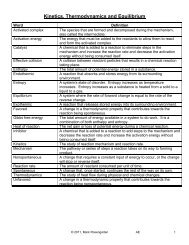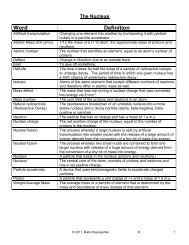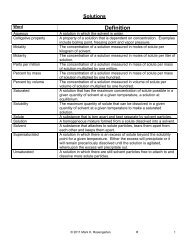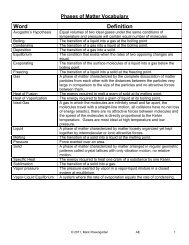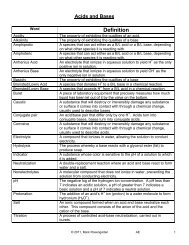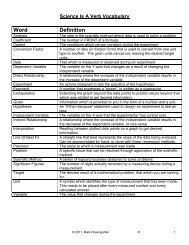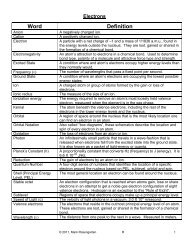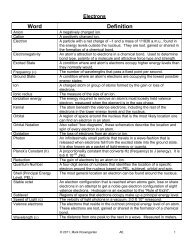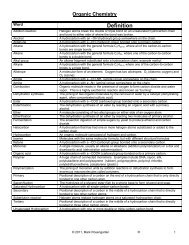Unit 4 - Mark Rosengarten
Unit 4 - Mark Rosengarten
Unit 4 - Mark Rosengarten
You also want an ePaper? Increase the reach of your titles
YUMPU automatically turns print PDFs into web optimized ePapers that Google loves.
Calculating Weight-Average Atomic Mass<br />
The atomic masses given on the periodic table are WEIGHT-AVERAGED masses. This is calculated using both the<br />
masses of each isotope and their percent abundances in nature. For the purposes of simplicity, we will round<br />
weight-average mass to the THOUSANDTHS place.<br />
To find the weight-average mass of an element given the mass of each isotope and each isotopes percent abundance:<br />
WAM = (mass isotope 1 X % / 100 ) + (mass isotope 2 X % / 100 ) + (mass isotope 3 X % / 100 ) + <br />
So, for the four isotopes of iron:<br />
Mass of<br />
Isotope<br />
(amu)<br />
Notation 1<br />
Symbol – mass #<br />
%<br />
Abundance<br />
in Nature<br />
54 Fe-54 5.845%<br />
56 Fe-56 91.754%<br />
57 Fe-57 2.119%<br />
58 Fe-58 0.282%<br />
Weight average mass of Fe is:<br />
WAM = (54 X 5.845 / 100 ) + (56 X 91.754 / 100 ) + (57 X 2.119 / 100 ) + (58 X 0.282 / 100 )<br />
WAM = (3.156) + (51.382) + (1.208) + (0.164)<br />
WAM = 55.910 amu<br />
Another way to look at this is as follows: take 5.845% of 54 (which is 3.156), then take 91.754% of 56 (which is<br />
51.382), then take 2.119% of 57 (which is 1.208) and then finally 0.282% of 58 (which is 0.164). Take the four<br />
numbers you get as a result and add them together, and you have the weight-average mass!<br />
Note that this is still not exactly the same as the listed weight-average mass on the Periodic Table. The isotope<br />
information you used to solve this problem came from the National Nuclear Data Center at Brookhaven National<br />
Laboratory. The weight-average mass given on the Periodic Table may include the other isotopes of iron, which are all<br />
radioactive and make up a very tiny percentage of iron’s mass. The weight-average mass is based on the<br />
abundance of the naturally occurring isotopes of that element.<br />
Also, protons and neutrons do not weigh exactly 1 amu. Neutrons weigh a tiny fraction more than protons do. An<br />
atomic mass unit is actually an average mass, found by taking the mass of a C-12 nucleus and dividing it by 12.<br />
Is how it is shown on the Periodic Table’s key.<br />
Here’s another example problem:<br />
Boron (B) has two naturally-occurring isotopes. B-10 has a mass of 10.0 amu and makes up 19.80% of all B<br />
atoms. B-11 has a mass of 11.0 amu and makes up 80.20% of all B atoms. What is the weight-average mass<br />
of boron?<br />
WAM = (10.0 X 19.80 / 100 ) + (11.0 X 80.20 / 100 ) = 10.802 amu<br />
Basically, you are taking 19.80% of 10.0, then taking 80.20% of 11.0 and adding the two numbers together.<br />
© 2011, <strong>Mark</strong> <strong>Rosengarten</strong> AE 4



